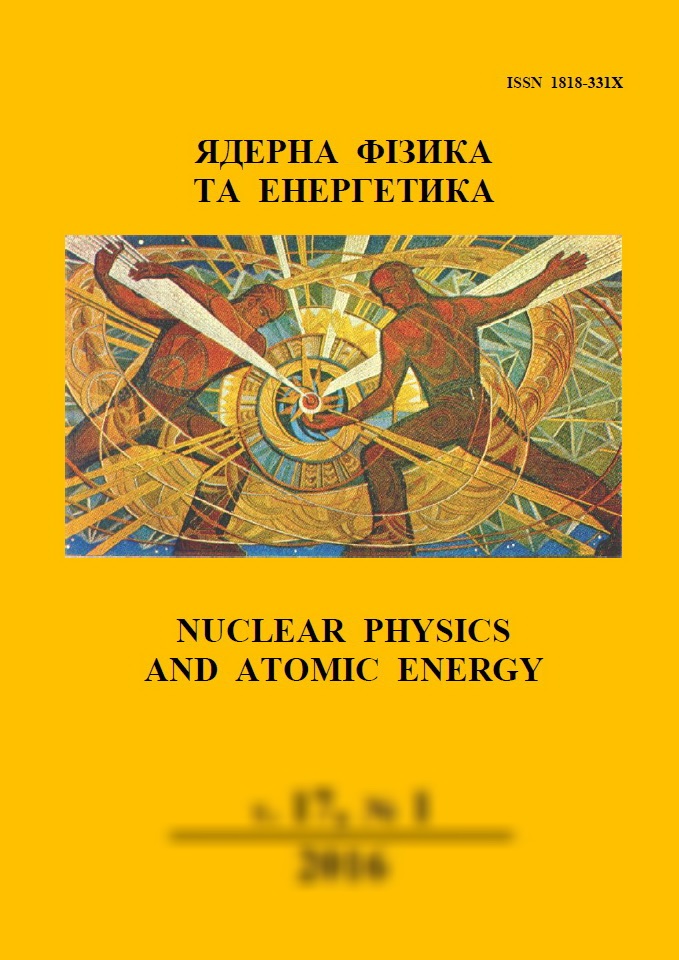 |
ßäåðíà ô³çèêà òà åíåðãåòèêà
Nuclear Physics and Atomic Energy
ISSN:
1818-331X (Print), 2074-0565 (Online)
Publisher:
Institute for Nuclear Research of the National Academy of Sciences of Ukraine
Languages:
Ukrainian, English
Periodicity:
4 times per year
Open access peer reviewed journal
|
Nucl. Phys. At. Energy 2020, volume 21, issue 4, pages 347-353.
Section: Radiobiology and Radioecology.
Received: 21.03.2020; Accepted: 17.11.2020; Published online: 28.01.2021.
 Full text (en)
Full text (en)
https://doi.org/10.15407/jnpae2020.04.347
90Sr adsorption from the aquatic environment of Chornobyl exclusion zone by chemically enhanced TiO2
I. F. Mironyuk1, I. M. Mykytyn1, O. Ye. Kaglyan2, D. I. Gudkov2, H. V. Vasylyeva3,*
1 Department of Chemistry, Vasyl Stefanyk Precarpathian National University, Ivano-Frankivsk, Ukraine
2 Institute of Hydrobiology, National Academy of Sciences of Ukraine, Kyiv, Ukraine
3 Department of Theoretical Physics, Uzhgorod National University, Uzhgorod, Ukraine
*Corresponding author. E-mail address:
h.v.vasylyeva@hotmail.com
Abstract:
This paper describes the testing of titanium dioxide, chemically modified by arsenate groups, as an adsorbent of 90Sr from the component of aquatic ecosystems of the Chornobyl exclusion zone. It is shown, that the chemical composition of the aquatic environment impacts 90Sr adsorption. The 4As-TiO2 adsorbent reduces the activity of some samples by almost 100 %, which indicates selectivity and high adsorption capacity of the adsorbent in relation to 90Sr. In some experiments, this value reached 100 %, and the activity was reduced to the level of the maximum permissible 90Sr concentration.
Keywords:
Chornobyl exclusion zone, fish, scale, specific activity, 90Sr, Ò³Î2.
References:
1. I.F. Mironyuk et al. Effects of chemosorbed arsenate groups on the mesoporous titania morphology and enhanced adsorption properties towards Sr(II) cations. Journal of Molecular Liquids 282 (2019) 587.
https://doi.org/10.1016/j.molliq.2019.03.026
2. I.F. Mironyuk et al. Highly efficient adsorption of strontium ions by carbonated mesoporous TiO2. Journal of Molecular Liquids 285 (2019) 742.
https://doi.org/10.1016/j.molliq.2019.04.111
3. I.F. Mironyuk et al. Adsorption of Sr(II) cations onto phosphated mesoporous titanium dioxide: Mechanism, isotherm and kinetics studies. Journal of Environmental Chemical Engineering 7(6) (2019) 103430.
https://doi.org/10.1016/j.jece.2019.103430
4. D.I. Gudkov et al. Peculiarities of radionuclides distribution in the main components of aquatic ecosystems within the Chernobyl accident exclusion zone. Aquatic Ecosystem Research Trends (2009) p. 383.
5. O.Ye. Kaglyan et al. Radionuclides in the indigenous fish species of the Chernobyl exclusion zone. Yaderna Fizyka ta Energetyka (Nucl. Phys. At. Energy) 13(3) (2012) 306. (Rus)
https://jnpae.kinr.kyiv.ua/13.3/Articles_PDF/jnpae-2012-13-0306-Kaglyan.pdf
6. O.Ye. Kaglyan et al. Fish of the Chernobyl exclusion zone: Modern levels of radionuclide contamination and radiation doses. Hydrobiological Journal 55(5) (2019) 86.
https://doi.org/10.1615/HydrobJ.v55.i5.80
7. ISO 18589-5:2019. Measurement of radioactivity in the environment – Soil – Part 5: Strontium 90 – Test method using proportional counting or liquid scintillation counting. 2-nd ed. (ISO, 2019) 2 p.
https://www.iso.org/standard/69074.html
8. Workshop on Veterinary Radiobiology. Ed. by A.D. Belova (Moskva: Agropromizdat, 1988) 90 p. (Rus)
9. S. Levchuk. Handbook of Basic Methods for Determining the Activity of Radionuclides (Kyiv, 2016) 116 p. (Ukr)
http://uiar.org.ua/Dovidnyk.pdf
10. H.V. Vasylyeva et al. Àdsorption of Co2+ and radioactive 60Ñî by mesoporous TiO2. Chem. Phys. Techn. Surf. 10(4) (2019) 446.
https://doi.org/10.15407/hftp10.04.446
11. H.N. Tran et al. Mistakes and inconsistencies regarding adsorption of contaminants from aqueous solutions: a critical review. Water Res. 120 (2017) 88.
https://doi.org/10.1016/j.watres.2017.04.014
12. A.Ye. Kaglyan et al. Radionuclides in fish of the Chernobyl exclusion zone: species-specificity, seasonality, size- and age-dependent features of accumulation. RAD Proc. of “Third Inter. Conf. on Radiation and Application in Various Fields of Research”, Budva, Montenegro, June 8 - 12, 2015 (Budva, 2015) p. 249.
13. J.S. Nelson. Fishes of the World. 4-th ed. (John Wiley & Sons, Inc, 2006).
Book
14. Brined Cheeses. Ed. by A.Y. Tamime. (Blackwell Publishing Ltd, 2006).
Book
15. I.M. Mehdawi, A. Young. Antibacterial composite restorative materials for dental applications. In: Biomaterials and Medical Device. Ed. by L Barnes, Ian Cooper (Elsevier, 2014) p. 199.
https://doi.org/10.1533/9780857097224.2.199
16. P.W. Brown. Calcium Phosphates in Biomedical Engineering. Encyclopedia of Materials: Science and Technology (2001) p. 893.
https://doi.org/10.1016/B0-08-043152-6/00170-4
17. K.M. Mackay, R.A. Mackay, W. Henderson. Introduction to Modern Inorganic Chemistry. 6-th ed. (London: Nelson Thomes Ltd, 2002) 467 p.
Book
18. A. Maxwell et al. Rapid method for determination of radiostrontium in emergency milk samples. Journal of Radioanalytical and Nuclear Chemistry 279(3) (2009) 757.
https://doi.org/10.1007/s10967-008-7368-3
19. H. Vasylyeva et al. Adsorption of Barium and Zinc Ions by Mesoporous TiO2 with Chemosorbed Carbonate Groups. Physics and Chemistry of Solid State 20(3) (2019) 282.
https://doi.org/10.15330/pcss.20.3.282-290
20. Calcium Phosphate. Compound Summary. National Library of Medicine. National Center for Biotechnology Information.
https://pubchem.ncbi.nlm.nih.gov/compound/Calcium-phosphate
21. F-G. Simon, V. Biermann. Chapter 4 – Behaviour of uranium in elemental iron and hydroxyapatite reactive barriers: column experiments. Trace Metals and other Contaminants in the Environment 7 (2005) 77.
https://doi.org/10.1016/S0927-5215(05)80008-6
22. International Basic Safety Standards for Protection against Ionizing Radiation and for the Safety of Radiation Sources. Safety Standards. Safety series No. 115 (Vienna: IAEA, 1996) 370 p.
https://gnssn.iaea.org/Superseded%20Safety%20Standards/Safety_Series_115_1996_Pub996_EN.pdf
